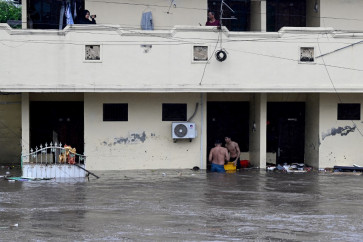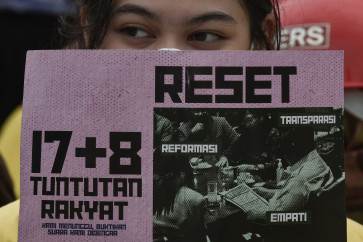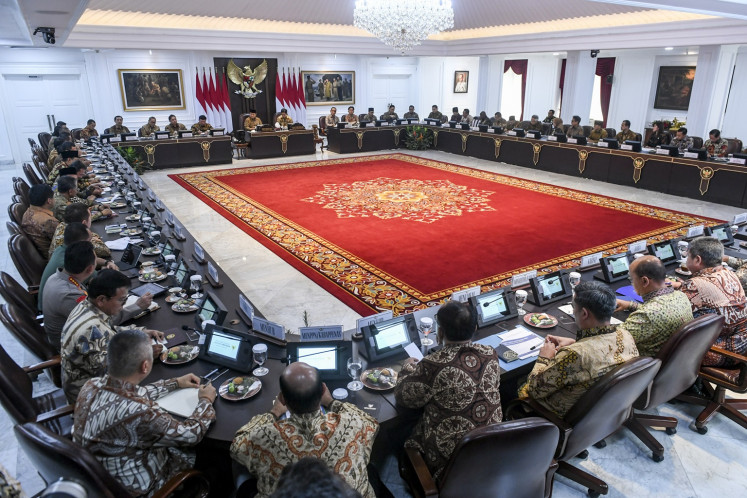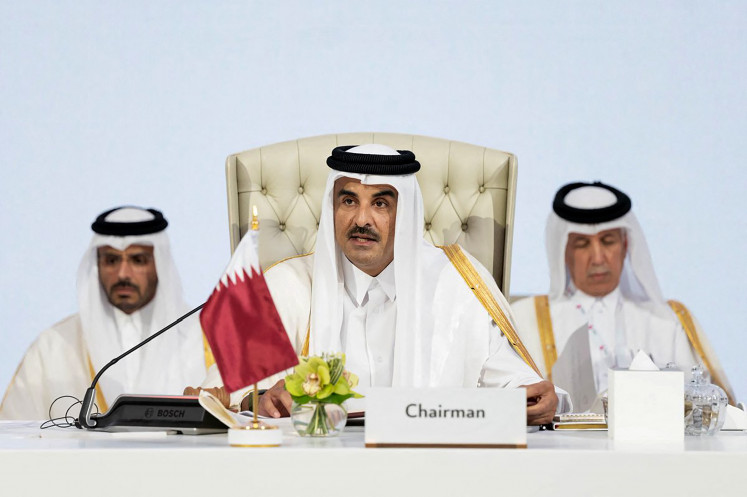Popular Reads
Top Results
Can't find what you're looking for?
View all search resultsPopular Reads
Top Results
Can't find what you're looking for?
View all search resultsHighlights from the first Jakarta ceramic biennale
Hidden Growth VIII by Lie Fhung
Change text size
Gift Premium Articles
to Anyone
Hidden Growth VIII by Lie Fhung. JP/Carla Bianpoen
In 1976, the late Indonesian ceramist Hildawati Soemantri broke through all conventions by holding an installation, the first ever in Jakarta, consisting of broken ceramic parts to reveal life’s fragile state.
But while she proved ceramics to be a worthy medium for personal expression, it has remained in the backseat of contemporary art.
Curators of contemporary art like Asmudjo Jono Irianto and Rifky Effendy who studied ceramics at the Bandung Institute of Technology, have been actively promoting the medium, curating exhibitions of both established and upcoming ceramists. Initiating the first Jakarta Contemporary Ceramics Biennale, they wish to focus the attention on ceramics as a legitimate medium in contemporary art.
Running from Dec. 19, 2009 to Jan. 20, 2010 at the North Art Space Jakarta, the biennale, with its subtitle “Ceramic Art: In Between”, suggests the curators are aware that some of the works may not be fitting for a biennale exhibition.
Nevertheless, the many fine pieces of ceramic art highlight a variety that many would not have expected in this medium. Some people might wonder why there should be a special biennale of works made in a certain medium, when contemporary art includes many mediums.
Highlights of the exhibition include some of the finest pieces of ceramic art, sometimes combined with other materials, such as the works by Indonesian born, HK-based Lie Fhung (b. 1969), whose solo exhibition “Flight” at CP Artspace in 2005 and “Corporeal Dream” at SIGIarts Gallery earlier this year were a testament to both her refined skill and her ability to visualize the conceptual through the medium of ceramics, combined with other materials.
The same can be said of Titarubi (b. 1968) whose visual expression through ceramics has been featured in various exhibitions. In this biennale, Titarubi brings a ceramic sculpture featuring a child’s head covered with Arabic script. It is a visualization of her concern relating to the religious education of her children in school.
Of fine texture and refined craftsmanship are the works of Desziana (b. 1965), featuring white ceramic plate porcelain on which vague imprints of lonely trees or branches can be seen. Titled Accessory Fragile Handkerchiefs, evoking a sense of tender fragility, the works are of unusual depth.
Fine finishing also marks Thai artist Krisaya Luenganantakul’s work, who received her ceramics training in Oregon and New York. She combines near traditional appearance with what looks like feminist expression – a woman’s womb, a house, flowers and scissors.
Superhero 2 by Taufiq Panji Wisesa. JP/Carla Bianpoen
Particularly interesting is the wall installation of ceramic tiles by Ferry Pharama (b. 1961) featuring the flow of his thoughts in images produced using the raku technique to achieve distinctive colors, and polished surfaces marked by cracks with some silver or gold. Singapore’s leading ceramic artist Jason Lim presents an installation of vessels in Still/Life 2, which seeks to undergo a process, in the likeness of Life. Made of terra cotta clay, the vessels are initially empty. But after the exhibition opened, Jason filled them with some water, which starts the process of decay, first cracking then decomposing and ultimately becoming clay again, after two months.
“Ashes to ashes,” says Jason. Life and death are also Malaysian Mohd Roslan Ahmad’s theme (b. 1963) who presents white bottles with spiraling lines made of homegrown bone china and clay using the hand-throwing method.
Fresh, funny and creative, the trio Tromarama, known for their video works that were shown in the Second Singapore Biennale, made ceramic tableware thrown on the floor combined with a video showing the same ware in daily use. In the same vein, Herra Pahlasari Saefullah made use of fine china for her installation and video titled Let’s Have a Cup of Happiness.
In contrast, Taufiq Panji Wisesa explores social issues in Superhero 2, an installation of bodies with wolves’ head.
Endang Lestari’s installation of women workers and their red suitcase evoke a sense of the increasing number of women now working outside the home.
Of course one cannot miss the works of Malaysian artists, like the aesthetic porcelain by Malaysian Shamsu Mohamad, the hybrid sculptures by Umibaizurah Mahirismail, Ahmad Abu Bakar, and the American and Italian artists of the Gaia Art Center.
There are also works by Albert Yonathan Setiawan whose residency in Japan transpires in his work, Evy Yonathan’s funny, and sometimes ironic sculpted faces, Nadya Savitri’s small installation of cream and perfume wrappings, the master ceramist F. Widayanto who is considered Indonesia’s Salvador Dali, the excellent precision work Ikan by Endros Sungkowo.
Other participants include A.A Ivan W.B., Ahadiat Joedawinata, Aries B.M., Dona Prawita Arissuta, Hadrian Mendoza, Handiwirman Saputra, Harry Mahardika, Ika W. Burhan, Ira Suryandari, Jenny Lee, Nia Gautama, Mirjam Veldhuis, Natas Setiabudhi, Noor Sudiyati, Nurdian Ichsan, Ponimin, Kang Sri Hartono, Tisa Granicia and Wiyoga Muhardanto.
It is expected that what appears as a mapping of contemporary ceramic practice in this biennale will eventually crystalize in a streamlined second biennale two years from now.
Jakarta Contemporary Ceramic Biennale
Ceramic Art: In Between
Dec. 19, 2009 – Jan. 20, 2010
North Art Space
Pasar Seni Ancol
Jl. Lodan Timur no. 7, Jakarta
+62 21 64710319











